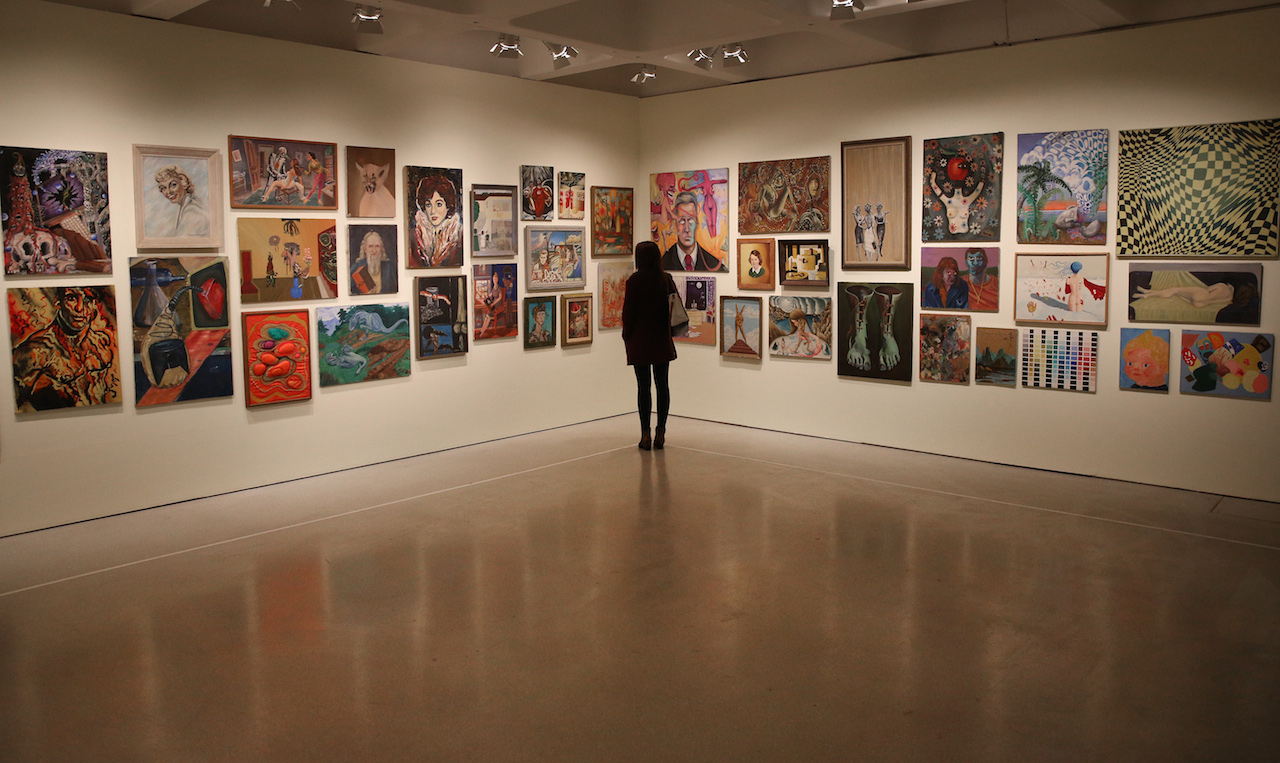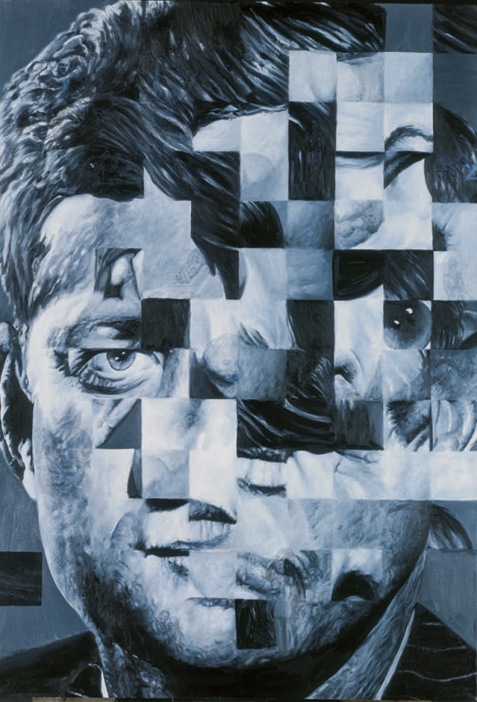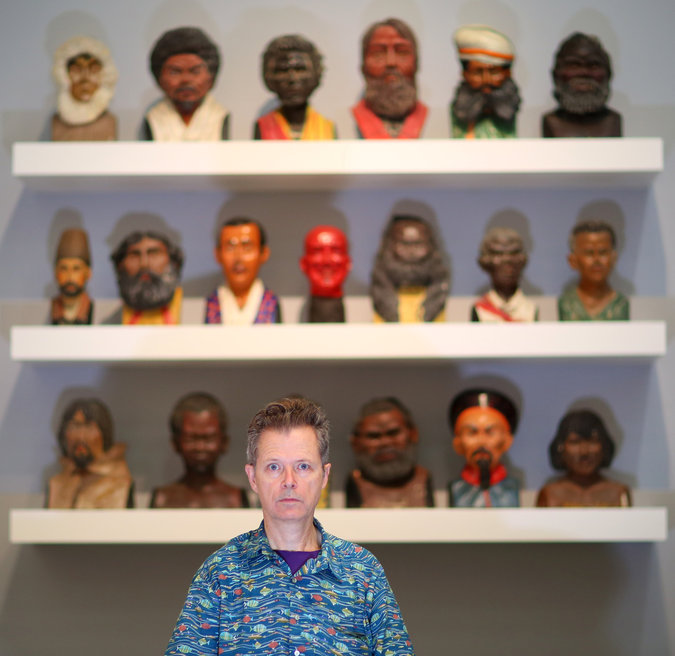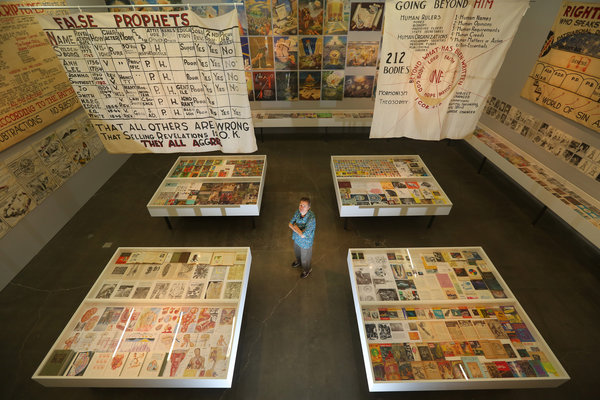Besides being a great artist himself, Jim Shaw is even more known as a collector; his 400 piece collection of thrift-store artworks, assembled when nobody paid attention to this kind of 'abandoned' art, gained him status as a 'historian of thrash'. He also founded (or revived) a religion, called O-ism: its theology centers on a goddess who can not be named, and is referred to as O. On october 7th a retrospective dedicated to his art and his collections opens at the New Museum in New York.
It all started in the seventies.
As an art student in Ann Arbor, Jim Shaw form the punk group Destroy All Monsters along with Mike Kelley, Niagara and filmmaker Cary Loren in 1973. Early! He left the band in 1976 and played with the original line up in reunion shows in 1995.
He then moved on to making art. As the New York Times wrote: "Along with Mr. Kelley and Paul McCarthy, another Los Angeles transplant from further east, Mr. Shaw became known in the 1980s and 1990s for a creepy brand of art – sometimes identified under the catchall term “abject” — that took a good, hard look at the hairy underbelly of the American dream."
The Guardian wrote in 2000, on the occasion of an exhibition of his collection of thrift-store art in ICA: "For 25 years, artist Jim Shaw has built up an eclectic collection of American junk, including his unwieldy chef-d'oeuvre - a revered collection of thrift-store paintings by anonymous amateurs bought from American flea markets, secondhand stores and charity shops."

And this: "Crucially, Shaw makes few claims for the thrift-store artists. These are not marginal visionaries like the so-called "Outsider" artists; nor are they necessarily Sunday painters - the derogatory term used since the 19th century for dilettante amateurs. Yet the ones that he has chosen - and he has "tended to be a little bit selective" - hit a bizarre discord in the soul, and Shaw himself sees all kinds of societal tendencies in them. "A lot of the more surrealist and expressionist paintings among them involve some sort of sinful activity," he says. "There seems to be a lot of puritanism, shame and guilt involved."
In recent years, I have been going back to an old love: outsider art. With my lovely wife Manuela Klerkx, we have collected works by Dutch outsiders (or naive artists, as they were called in the seventies) such as Evert de Graaf and Henk Lamm. And isnt't street art also the ultimate outsider art?
When you can't get inside, work outside...
First episode (of eight) of Beautiful Losers (must watch!)
The Beautiful Losers - Barry McGee, Margaret Kilgallen, Harmony Korine, Ed Templeton, Chris Johanson, Ryan McGinley ao - were inspired by surf and skate culture, cartoons, hobo art, letter signs: non-academic art, rooted in youth culture, just like Jim Shaw loves popular culture, especially cartoons and comics (something he shares with fellow student and punk artist Raymond Pettibon, who also came to the fore in the 1970s). In Shaw’s case, a lot of his early work depicted degenerate scenarios in pencil-on-paper comic-strip layouts. Pettibon does not use the strip format, but many of the personalities in his drawings – the tough guy, the jock, the druggy, the moll – come from pulp fiction and comics. This work by Shaw, seems very inspired by Pettibon.
The Guardian: "Shaw's project has artistic lineage. The search for the unschooled, the naive and raw in art has a pedigree throughout modernism, from Picasso marvelling at tribal masks to Jean Dubuffet's post-war search for "Art Brut"; literally "raw art", produced by the unschooled and marginal. Indeed, the elusive intellectual quest for authentic creativity can even be seen in the shaky needlework of Tracey Emin, and the work of certain American painters such as John Curran and Alex Katz, which look a bit "thrift store" in execution. In this context, Shaw's artists may be seen as genuine suburban primitives.
Equally, such junk-shop finds form a part of the history of objets trouvés and ready-mades - works found complete, and invested with status by the professional artist-discoverer. Upending this notion is a section in the archive labelled "Inspired By Modern Art".

Jim Shaw Untitled (Distorted Face Series: JFK) 1986. Oil on canvas 182.3 x 121.9 cm
"Dalà, Magritte and Van Gogh tend to be the biggest inspirations," he says. "It's that adolescent thing of loving surrealism and expressionism."
Few of the thrift-store artists have been in contact with Shaw, although one did phone him, having seen his work in Shaw's book, Thrift Store Painting. On one occasion, when the show was in Hawaii, someone recognised a painting she'd given to her sister in law, and which had ended up abandoned. "I gave her the painting back," says Shaw. "It turned out that her husband had told her to give up art." This tale of crushed creativity moved him, and he tried to encourage her to do more.
It looks as if Shaw has started something big. There are now several thrift-store painting-type sites on the internet - galleries include Huge Gallery, PSB Gallery, Friendly Toast and the Museum Of Bad Art. And now there are British collectors, including Tim Burke, who is having a show of his own more modest collection of Brit-thrift paintings at Coins, a west London coffee house, which includes paintings of Princess Diana, Spitfires and pub interiors. "They were abandoned," says Burke, "like orphans that needed a new parent."
I find that very moving. The love for the abandoned, the underbelly, the trash, the overlooked, the not-so-talented: there's lot to love there. Jim Shaw not only shines light on dark places (compared to white cube spaces, thrift-shops usually are dimly lit), but also, like a true archeologist, dug up some great Americana.
On wednesday, the Jim Shaw retrospective "The End is Here" opens at the New Museum, and seeing the photographs in The New York Times this looks like a cracking show. Here's what the NM website says: “The End is Here will present some of Shaw’s most iconic projects, including early airbrush drawings; large selections from his series “Dream Drawings” (1992–99), “Dream Objects” (1994–present), and the sprawling “My Mirage” (1985–91); and Labyrinth: I Dreamt I was Taller than Jonathan Borofsky (2009), a large-scale, immersive installation of sculptures and painted theatrical backdrops. These instantly recognizable works and series—which succeed in reinvigorating and complicating traditional categories like portraiture, history painting, figurations, and abstraction—have never before been brought together in a single exhibition. This survey will also include a presentation of his collection of thrift store paintings, originally shown in New York in 1991, as well as his ongoing collection of religious pedagogical materials. Presented under the title “The Hidden World,” this diverse assortment of pamphlets, posters, banners, and other ephemera catalogs the spiritual exhortations and admonishments of a constantly expanding pantheon of homegrown prophets and visionaries. These two collections demonstrate Shaw’s unique insight into the spiritual and aesthetic history of America and the ways in which the obscure, personal expressions he has collected have informed his own unique artworks. As part of his process, Shaw consistently relies upon in-depth historical research, the exploration of his own personal experience and subconscious, and the creation of fictitious histories and characters. The combination of these strategies results in a powerful evocation of the themes of belief, madness, materialism, and war, as they continue to influence contemporary life."

Jim Shaw at the New Museum, where his retrospective opens on Wednesday, october 7th. Credit Chang W. Lee/The New York Times

“For a lot of the things that I buy on eBay, I’m the only bidder.” Mr. Shaw, with part of his collection at the New Museum. Credit Chang W. Lee/The New York Times
Go and see the show!